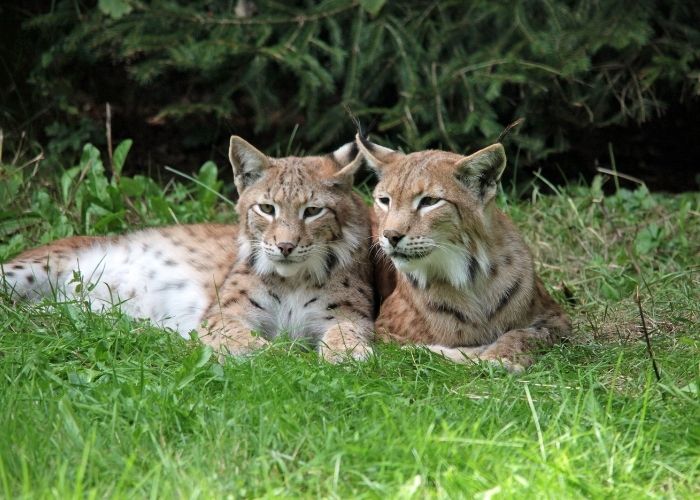MADRID – Although Europe is best known for its art cities, museums, historical monuments, and modern architecture, the diversity of wildlife that you can see in many areas and natural parks are astonishing. Also in Spain!
From the sly Eurasian Lynx deep in the deciduous forests of Ukraine and Scandinavia, to the colorful puffin that pops up in droves off the coast of Britain. So you don’t have to cross the ocean to catch a glimpse of the fascinating natural world, when there’s so much to see close to home.
PaulCamper has analysed which European countries can offer you the ultimate wildlife vacation. The Wildlife Travel Index analyses and compares wildlife data from different countries to assess which countries have the most wild species of fish, amphibians, birds, mammals and reptiles. The number of nature parks or protected areas are also included in the ranking.
Spain in third place
Spain finished in 3rd place in this ranking of Europe’s best wildlife holiday destinations, after France and Italy. Where the country surpasses the first two in the number of bird species that can be seen (382). In terms of number of fish species, the country with 803 species is equal to France. Spain’s total points total is 53, while Italy and France have 54 and 59 points respectively. Those numbers are based on the points obtained on various items such as reptile species, amphibians, bird species, mammal species, protected areas and national parks.
The top ten best wildlife vacation destinations also include: Greece, Ukraine, Sweden, United Kingdom, Germany, Portugal and Norway. The Netherlands is in 18th place and Belgium in 29th place.
What are the wildlife highlights in Spain?
Wildlife highlights in Spain are the Iberian lynx, Iberian wolf, dolphin, Iberian ibex and bearded vulture. Perhaps a little less easy to spot in the wild, because the Oso Pardo, the brown bear in the north of Spain, is rare. According to this index, the country has a total of 1,413 species (382 birds, 38 amphibians, 75 reptiles, 641 fish, 101 mammals). 28% of the land in Spain is protected.
The Big Five of Europe
Although countries such as France, Italy and Spain score highly when it comes to biodiversity and protected natural areas, the east and north have the best chance of encountering Europe’s “Big Five” in the wild: the brown bear, the gray wolf, the lynx, the bison and the wolverine (wolverine).
Total number in Europe: Brown bear: 17,000; Gray wolf: 17000; Lynx: 8000 – 9000; Bison: 6200; Glutton: 1000 -1250
The brown bear
There was an era when the brown bear was practically all over Europe. However, with the clearing of forests, the animals were forced to retreat to remote areas less accessible to humans, causing it to disappear in most countries. The global brown bear population consists of more than 200,000 individuals, of which about 100,000 live in Russia.
The brown bear is best seen in Romania, Sweden, and Finland. You also have a chance in Spain, such as in the Picos de Europa Natural Park in north-western Spain and in Somiedo in Asturias.
When is the best time to see bears? The best time is in the spring when they are hungry for food or in the fall when they are voraciously feeding in preparation for winter.
The lynx
The lynx was also once widespread in Europe. The medium-sized wildcat was nearly wiped out due to loss of habitat, poaching, and depletion of prey. However, from the 1970s onwards, the lynx received legal protection and reintroduction programs were initiated. Currently, there are about 9000 Eurasian Lynx in Europe, of which 2300-2400 in the Carpathians: 1200-1500 in Romania, 500 in Ukraine, and 300-350 in Slovakia. Between 2065 and 2170 Eurasian lynxes live in Finland, and about 1111 Iberian lynxes live in Spain.
Where is the best place to see the lynx? the Carpathians (2300 -2400) and Finland (2065-2170), Spain (1111).
When is the best time to see the lynx? The Eurasian lynx is best spotted from late October to early May. For the Iberian lynx in Spain, the best time to travel is from December to May.
Tips for responsibly discovering wildlife
Sanne Kuijpers, wild animal campaign manager at the World Animal Protection organisation, gives some tips for an animal-friendly holiday. As a tourist, you can help animals by avoiding wildlife attractions. For example by:
- Do not take a picture with a wild animal
- Not to cuddle, walk or swim with wild animals
- No oil feed, wash or ride elephants
- Not going to shows where wildlife performs tricks (circus or dolphin shows)
- Only visit really animal-friendly shelters, where no interaction with wild animals is possible and no animals are bred to keep young animals
- Or admire wild animals in the wild, from an appropriate distance


